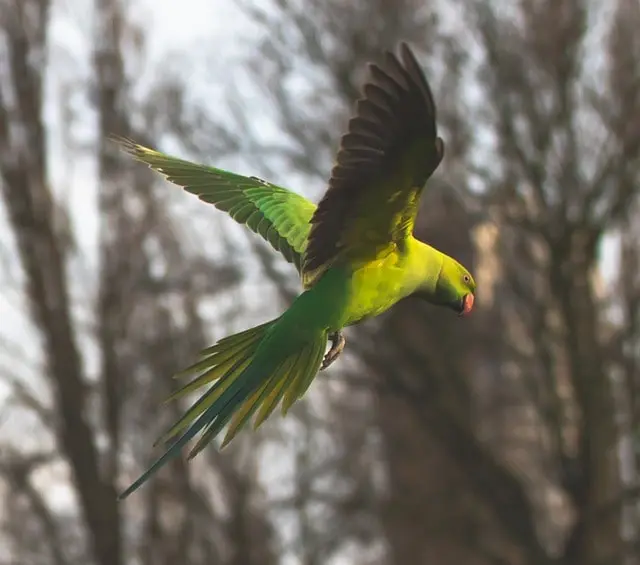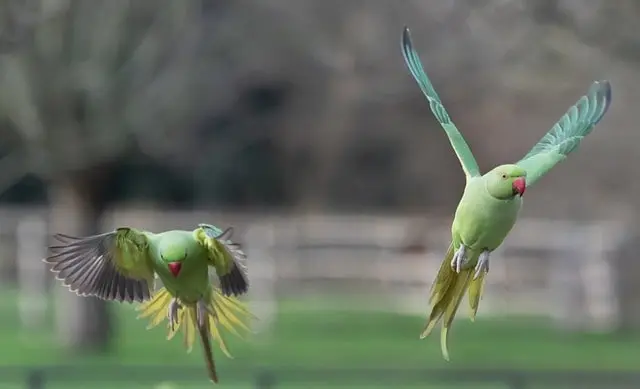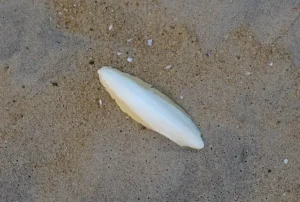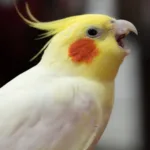Parrots do well as indoor pets and feel more secure in a known environment. But they will also try to sneak out at every given opportunity.
According to a study conducted by PLOS ONE in Australia, more than 90% of the birds that were reported to have escaped were parrots. They also state that parrot escapes are more common than acknowledged.
Even when inside the house, you should ensure that all doors and windows are closed. Without proper precautions, parrots can fly away.
That does not mean that you cannot take your parrot outside. But you should make proper arrangements.
The safest way to take your parrot outside is in a carrier. The enclosed space of the carrier can be a good start for a parrot because it helps them adjust to the outside environment.
You can also use a harness to keep your parrot from flying away but that requires some level of training before your bird gets comfortable with it.
Quick Navigation
Do Parrots Come Back If They Fly Away?
If a parrot flies away, it is unlikely that it will return on its own. Parrots cannot find their way back because they cannot navigate the outdoors.
All their life they have only seen the world from the confines of their cages. They will not know where your house is or what it looks like.
However, you should not panic in a situation like this. With help, escaped parrots can be located and brought back home. In most cases, parrots do not go too far and can be found in the nearby area.
Keeping the parrot’s cage outside can help them find their way as they are able to recognize their cages. You should spread out and look for them in trees and other places close to your house.
Sometimes, parrots can come back if they recognize familiar surroundings and people. However, you should not stop your search.
Calling out their name and using familiar bird sounds can tell them which way they should fly and they might just end up coming back to you.
Where Do Parrots Go When They Escape?
Parrots do not know where they are going and often wander off in any random direction. However, they tend to look for high positions to perch, so they may go to a tree or a tall building nearby.
They do not always fly far away unless they get spooked or are chased by a predator.
If they are flying outside for some time, they may get hungry and search for places where they can find food.
Again, they may not know where they are going, but they will follow their instincts and move forward. If they’re lucky, someone might find them and keep them.

Can An Escaped Parrot Survive In The City?
The longer your parrot stays outside, the lower its chances for survival. A captive parrot that’s been indoors most of its life, does not know how to navigate the city. It may not even be aware of all the dangers that would be waiting for it.
Unless you are able to capture your parrot in time or someone else finds them, they will have to contend with a number of obstacles. These are some of the challenges an escaped parrot would have to face in an urban setting:
Cold Weather
Most parrots come from regions that are hot and as a result, do not tolerate cold temperatures very well. If it is cold where you live, your parrot may not be able to make it through the night.
Danger From Predators
Parrots face predatory dangers from cats, dogs as well as larger birds. There have been numerous instances of cats attacking and eating pet parrots.
Lack Of Food And Shelter
If a parrot is able to avoid predators, it will have to look for food. There are no places in an urban environment where parrots can go to forage food.
They also do not just peck grains on rooftops like city birds. The best thing that can happen to your parrot is if someone provides them with food and shelter. Otherwise, their chances of survival in the city are not very good.
Should You Take Your Parrot Outside?
Taking your parrot outside has many benefits and provides them with enrichment opportunities. They get exposure to natural sunlight, which provides them with essential vitamin D.
Outdoor visits also allow the parrot to become more in tune with nature, which can reduce stress and stimulate them mentally.
They also become less fearful of new experiences. However, you should be careful when taking them outside. If they are not harness-trained, use a carrier to prevent them from flying away.

How To Train Your Parrot To Take It Outdoors?
Carrier cages are quite convenient for traveling but when you want to give your parrot the complete experience of being outside, harnesses can be a great idea. Following are the steps to train your parrot to take them outdoors:
Prepare Them For The Outdoor Experience
The outdoors can be overwhelming for a parrot at first, so you need to help them get used to the environment by taking them out in carrier cages. By letting them explore the outside world from the carrier, you can prepare them for the actual experience of going outside.
Harness Training
After you feel your parrot is ready to be taken outside, you can start working on harness training them. The most challenging part of harness training your parrot is being able to get them to wear the gear. Note that in order to put on the harness, your parrot should be allowing you to touch it.
You will have to handle your parrot a little bit where you hold their wings while they come in and out of the harness. So if your parrot does not accept touches, you first need to work on that.
Desensitize Them To The Harness
Before anything, you need to be sure, you’re parrot is not scared of the harness. Whenever you’re introducing a new object to your parrot, you should first desensitize them to it.
You can do this by showing them the harness and offering them a treat when they touch it. Let your parrot come near the harness and wait for them to touch it. Once they do, offer them a treat.
Let The Parrot Participate
When you’re putting the harness onto your parrot’s body, your parrot shouldn’t feel like you’re forcing it on them. Never try to strap on the harness. You want the parrot to come into the harness willingly. Also, adjust the harness collar size, so your parrot has enough room to get its head inside.
One of the ways you can do this is by target training. Hold out the harness in front of your parrot while keeping the target stick out. You can also simply use treats to get your parrot to target.
Let your parrot get its head through the harness and reward them when they do. Repeat this process a few times so that your parrot gets a hang of it. Then slowly put both wings through the harness. When you’re done, fasten the harness carefully and just enough so it fits your parrot.
Practice Indoors
Once your parrot has the harness on, practice moving with them on their perch before you take them outside. Move the harness so as to get your parrot to move with you. You need to be sure that your parrot understands the purpose of the harness and responds positively.
If you miss this step, your parrot might still try to fly away when you take it outside, which can make the harness tug on its body. So you need to make sure your parrot
FAQs
Can A Parrot Fly Away If Its Wings Are Clipped?
Yes, parrots can fly away even if their wings are clipped. They may not be able to fly very efficiently, but they can glide for certain distances. Also, you need to take into consideration, when their wings are clipped. Wings can grow back unnoticed, especially if they have been clipped near their next molting period.







